REVIEW PROTOCOL: ACTIVE
ID: REF-2025-65521Conclusions built strictly upon verifiable data and validated research.
Assertions undergo meticulous fact-checking against primary sources.
Delivering clear, impartial, and practical insights for application.
If you want one thing above all else from your daily trainer—comfort—the New Balance Fresh Foam X More v6 should be on your shortlist. It’s a true max‑cushion shoe with a towering stack of foam underfoot, but unlike some “pillowy” models that feel clumsy, the More v6 finally behaves like a proper running shoe, not just a soft walking sneaker.
New Balance Fresh Foam More v6
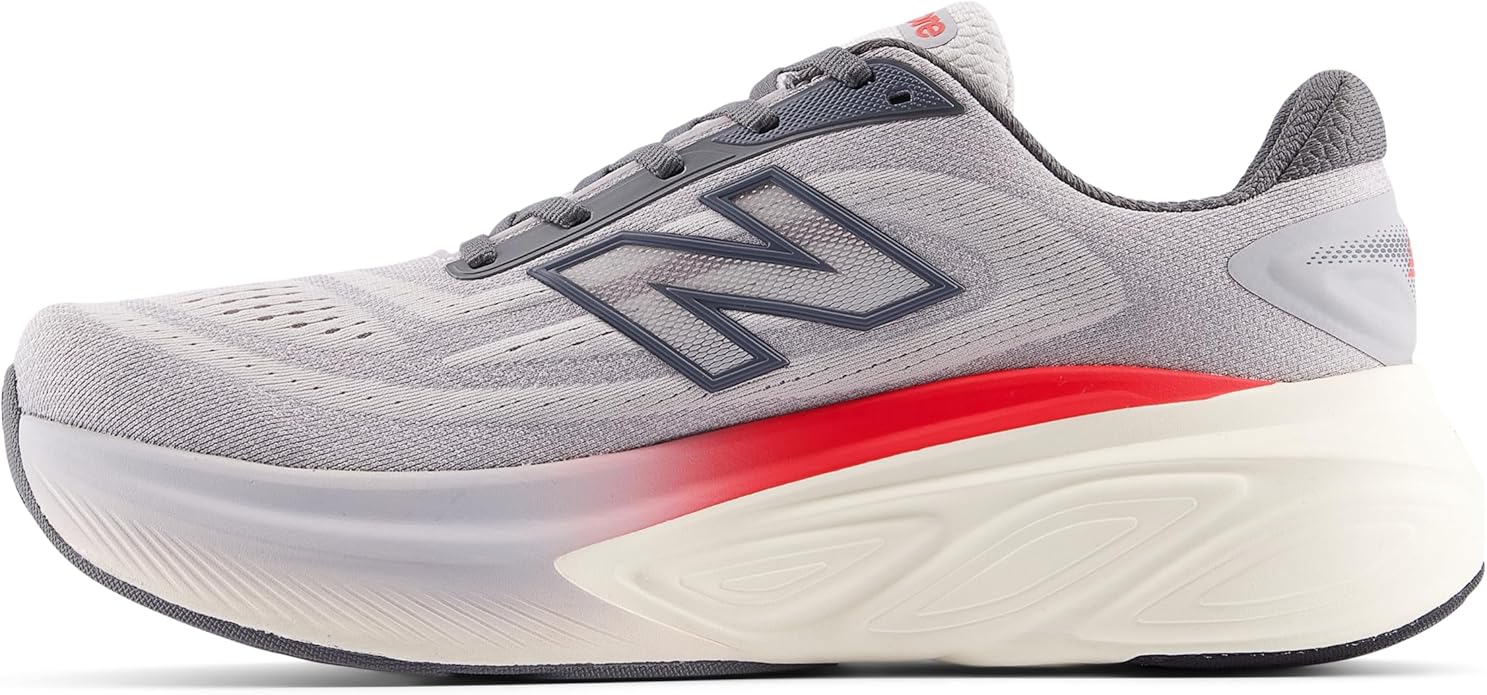
In this in‑depth review, we’ll break down what’s new, how it actually feels on the run, who it’s best for, and how it compares to other popular max‑cushion options.
At a Glance: Key Specs
- Stack height: 44 mm heel / 40 mm forefoot (4 mm drop)
- Midsole: Single‑density Fresh Foam X (no plates, no mixed foams)
- Weight: 11.1 oz / 316 g (US men’s 9, measured)
- Price: $160 MSRP
- Best for: Easy runs, recovery runs, long slow miles, walking, all‑day standing
If you’re not sure how these numbers translate to real‑world performance, you may want to start with a general guide on how to choose the right running shoes.
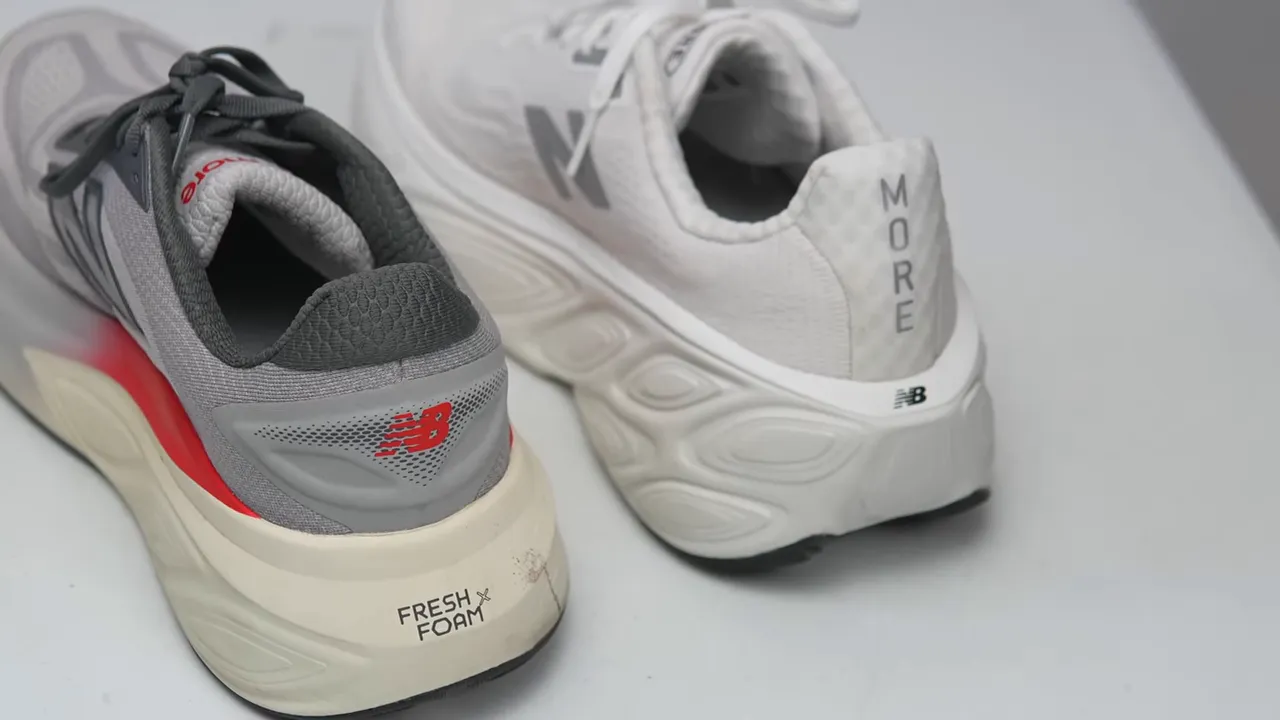
What’s New in the Fresh Foam X More v6?
New Balance didn’t rip up the blueprint for the v6—they refined it. The shoe is still built around a thick slab of Fresh Foam X, but a couple of smart tweaks make it feel more balanced and more “runnable” than past versions.
1. Slimmer Heel Flare = Less Clunk
Previous versions of the More had a very wide, flared heel, which made them stable but also a bit awkward and bulky. In v6, New Balance subtly trims back that outer flare.
- You still get a broad, confidence‑inspiring base, especially in the heel.
- But you lose that “elbows‑out” feel and visual bulk.
- Transitions from heel to midfoot feel smoother and less blocky.
Result: The shoe still feels secure, but no longer like you’re standing on a platform shoe.
2. Gentle Rocker for Natural Transitions
The rocker profile is another key change. Instead of a sharply curved forefoot (like earlier versions), the More v6 uses a long, mild rocker:
- The stack stays thick and consistent through most of the forefoot.
- It only tapers near the very front of the toe.
- This encourages a smooth, unforced roll through your stride.
You’re not being shoved onto your toes; you’re just getting subtle help moving forward.
Midsole Feel: Soft, Deep Cushion Without the Mush
The entire midsole is single‑density Fresh Foam X—no plates, no dual‑density posts, no fancy layering tricks.
What that means on the run:
- Comfort first: This is a plush, protective ride designed to take the sting out of long or tired legs.
- Consistent feel: From heel to toe, you get the same foam character—no surprises, no “dead spots.”
- Controlled softness: It’s soft and forgiving, but not so squishy that you feel unstable or bogged down.
If you’re new to max‑cushion shoes and want to see how they fit into a broader shoe rotation, check out this overview of running shoes decoded and choosing the perfect pair for your unique gait.
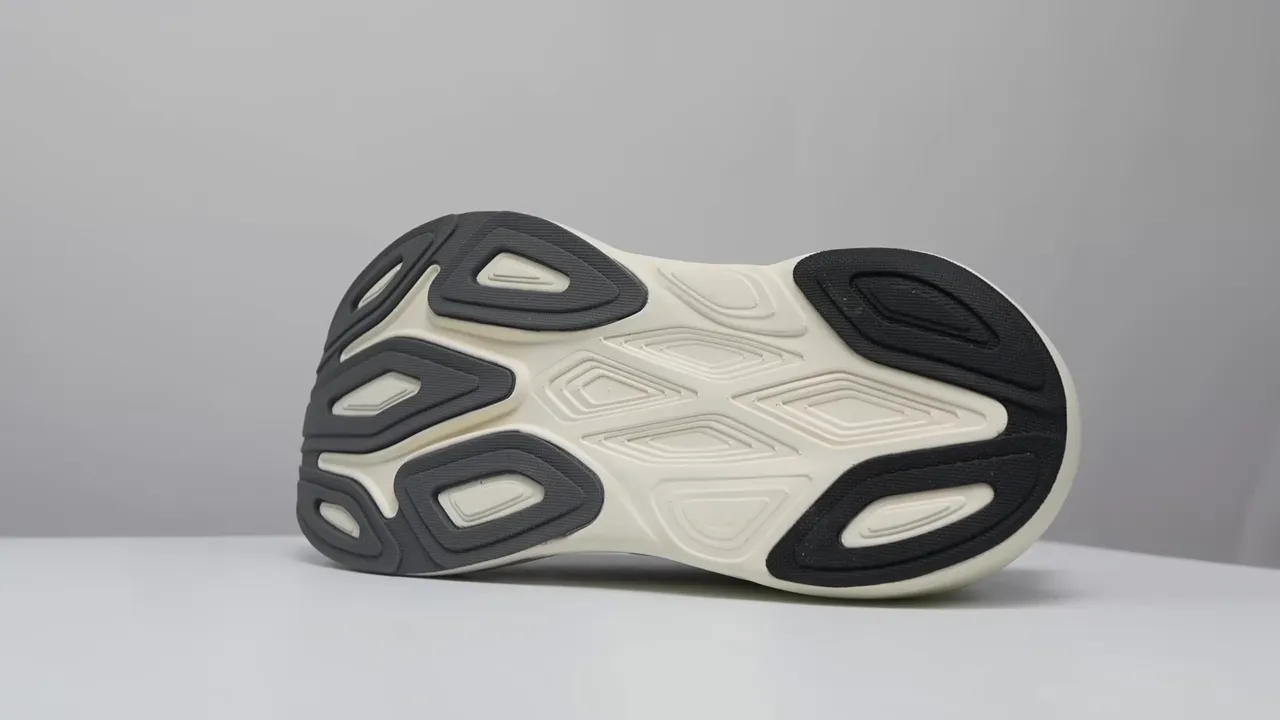
Outsole & Durability
The outsole design combines strategic rubber coverage with some exposed foam under the arch.
- High‑wear areas (heel, forefoot) are covered with thick, durable rubber.
- The cutout in the middle exposes Fresh Foam X but doesn’t compromise durability in normal road use.
- Traction is solid on dry pavement and light wet conditions.
Over time, you can expect the usual cosmetic scuffing on the exposed foam, but the rubber in key zones should hold up for the kind of mileage you’d reasonably put on a max‑cushion daily trainer.
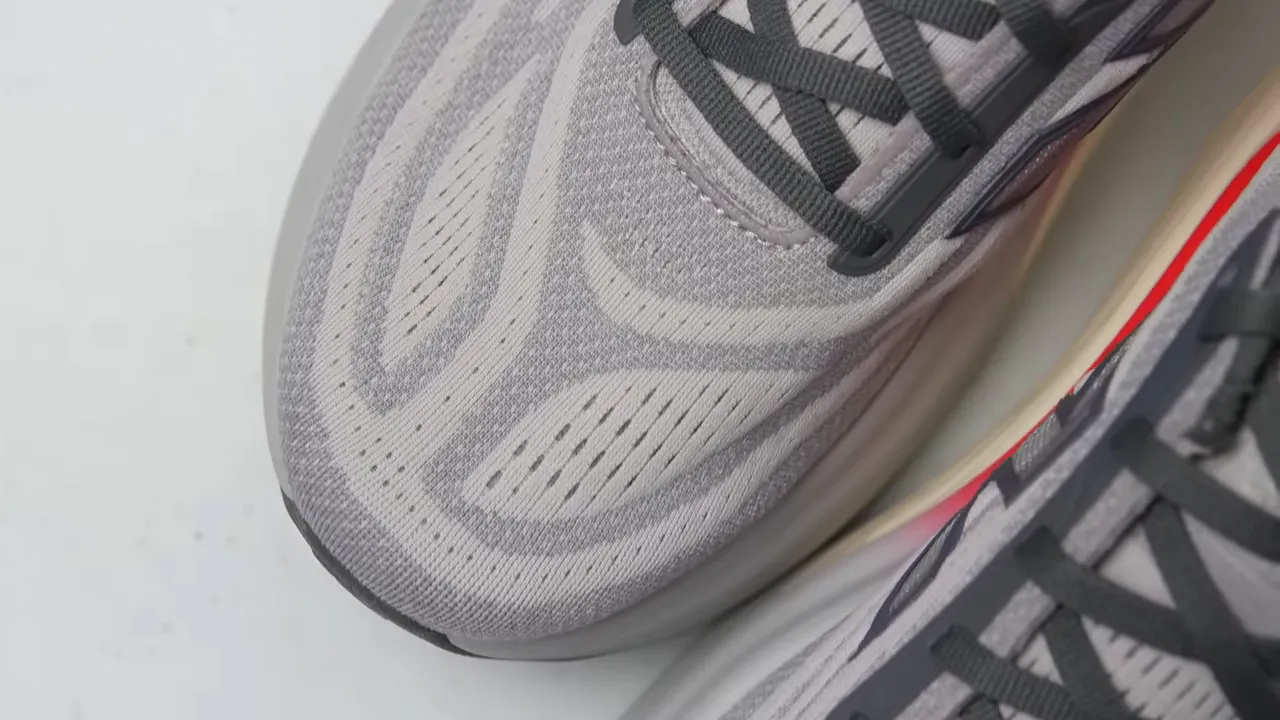
Upper: Plush, Secure, and a Bit Warm
Everything about the upper says comfort:
- Materials: Soft engineered mesh that feels gentle on the foot.
- Padding: Well‑padded tongue, collar, and heel cup for a “cushioned couch” feel around the ankle.
- Heel hold: Once laced correctly, the heel cup locks in securely and avoids slipping on longer runs.
However, that comfort comes with two trade‑offs:
- Warmth:
All that padding and material makes the shoe noticeably warm in hot weather. It shines in cooler temps but may feel stuffy mid‑summer. - Stretchy Laces:
New Balance uses stretchy, accommodating laces. They’re great for comfort but can loosen as you run.- For short, easy jogs this is minor.
- For longer runs or if you like a “locked‑in” feel, you may want to swap to standard flat performance laces for a more secure fit.
If you’re still exploring which shoe types and fits work best for you, this guide to the best running shoes for beginners is a helpful complement.
Fit & Sizing
- Fit: True to size for most runners.
- Width: Naturally roomy through the forefoot; also available in wide sizes, which is great if you have broader feet or like extra toe splay.
- Volume: The toe box feels generous in both width and height, complementing the soft underfoot ride.
Who will like this fit:
- Runners with wide or high‑volume feet.
- People who dislike tight, performance‑race uppers.
- Those who want extra space for swelling on very long runs or all‑day wear.
If your feet are particularly wide or tricky to fit, you may also want to explore dedicated options like these best running shoes for wide feet.
How the More v6 Actually Feels on the Run
This is where the shoe’s personality becomes clear.
Best Use: Easy & Recovery Days
The More v6 excels at:
- Easy runs after hard sessions
- Long, slow weekend miles
- Recovery jogs when your legs feel beat‑up
- Walking or standing all day for work or travel
The cushioning soaks up impact and makes each step feel less demanding. The gentle rocker and broad base keep things smooth and stable, especially when you’re tired.
What It’s Not Great At
- Speed work & intervals: At over 11 oz, this is not a tempo or race day shoe.
- Snappy toe‑off: There’s no plate, no aggressive rocker, and no particularly “poppy” foam feel. It’s more about comfort than speed.
If you’re building your first running routine and aren’t yet doing speed work, pairing this shoe with a structured plan—like this custom running plan (free)—is a smart way to protect your legs while your mileage ramps up.
Pros & Cons
Pros
- Deep, consistent cushioning that feels mature and controlled, not sloppy
- Stable, wide platform without the exaggerated heel flare of past versions
- Very comfortable upper with a secure heel pocket
- Durable rubber in high‑wear areas for solid longevity
- Available in wide widths, making it accessible for many foot shapes
Cons
- Heavy and bulky for any kind of fast running
- Stretchy laces can loosen and may require mid‑run re‑tightening or replacement
- Warm upper that’s less ideal for hot, humid climates
- Price bump to $160 compared with previous versions
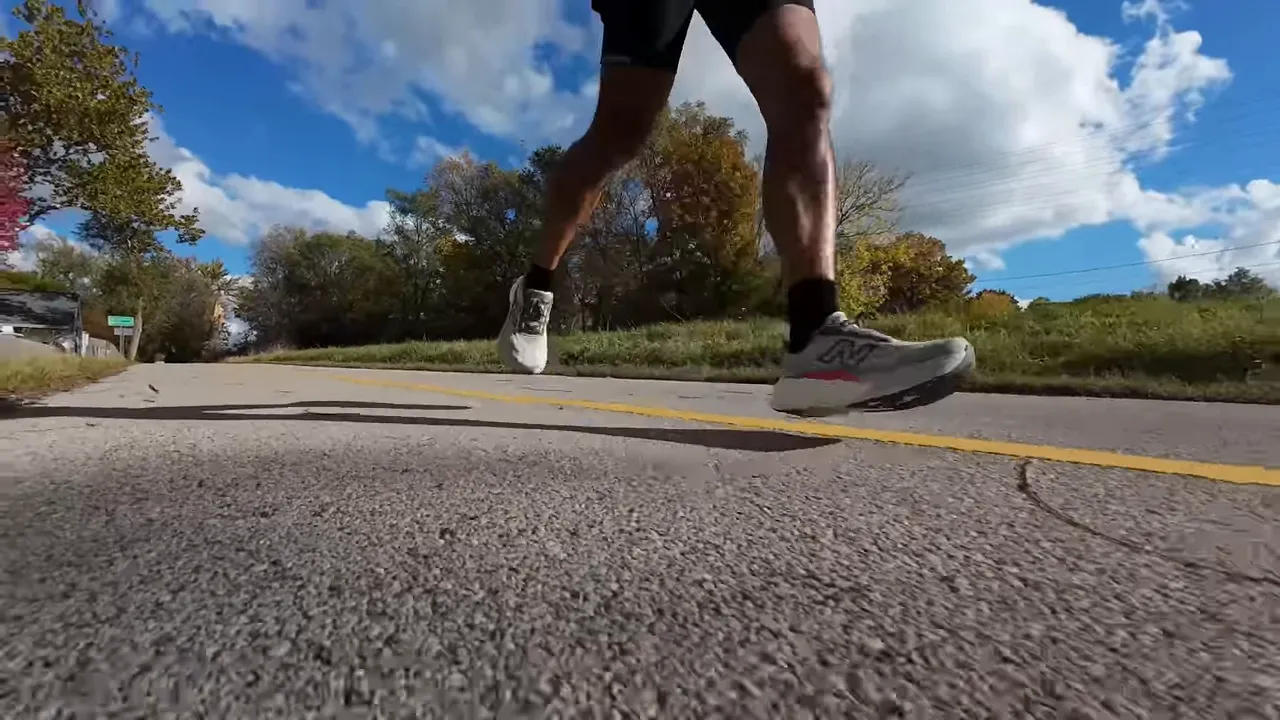
Who Should Buy the New Balance Fresh Foam X More v6?
The More v6 is a strong choice if you:
- Want a max‑cushion daily trainer primarily for easy and recovery runs.
- Spend long hours on your feet (teachers, nurses, retail workers) and want one shoe that works for both daily wear and gentle runs.
- Prefer a wide, stable base and don’t like shoes that feel narrow or tippy.
- Need or appreciate wide sizing options.
It’s also a friendly option for:
- Newer runners who want maximum protection while they slowly build mileage. If that’s you, pairing this shoe with a smart plan like the How to Start Running From Scratch – The Smart Guide will help you avoid common beginner mistakes.
You may want to avoid the More v6 if:
- You want a light, peppy trainer for tempo runs or races.
- You run in hot climates and prioritize breathability over plush comfort.
- You strongly prefer a snug, race‑style upper.
If you deal with specific issues like heel pain or arch problems, it’s worth also looking at focused options such as the best running shoes for plantar fasciitis to compare support and cushioning styles.
Price & Value
- Retail price: $160 (about a $5 increase over the prior version).
For a modern max‑cushion trainer from a major brand, $160 is right in the middle of the current market. You can save some money by hunting down leftover v5 stock, but availability appears limited, and the v6 is clearly the more refined running shoe.
If you’re more price‑sensitive, it may help to see how the More v6 stacks up against other choices in broader roundups like the best running shoes overall.
How It Compares to Other Max Cushion Shoes

vs. Hoka Bondi 9
The Hoka Bondi 9 is a long‑standing giant in the max‑cushion category.
- Ride feel: The Bondi is slightly livelier and more nimble underfoot, with a more noticeable rocker.
- Upper: Typically a bit more performance‑oriented and less puffy than the More.
- Price: Usually sits higher, around $175.
Choose the Bondi if you want a touch more responsiveness and don’t mind paying a bit extra or adjusting sizing (many runners go up half a size in Hoka).
vs. Puma MagMax
The Puma MagMax is the “fun shoe” of this trio.
- Ride feel: Very bouncy and energetic, while still wide and stable.
- Upper: Less padded, more performance‑leaning with a knit tongue and restrained heel padding.
- Price: Typically the most expensive at around $180.
Pick the MagMax if you want maximum bounce and excitement from your max‑cushion trainer and are willing to pay for it.
Where the More v6 Fits
The New Balance Fresh Foam X More v6 sits as the comfort‑focused, value‑sensible option:
- Softer and plusher than many standard trainers.
- Less lively than the MagMax, but also less expensive.
- More “running‑ready” than some previous New Balance max‑cushion offerings that leaned heavily into lifestyle comfort.
If you’re building a small rotation, consider:
- More v6 for easy/recovery runs.
- A lighter daily trainer or tempo shoe for faster work.
- A performance model for racing.
For more ideas about building that kind of rotation, start with this guide to the best running shoes for different distances.
Helpful Extras: Watches & Training Support
A max‑cushion shoe like the More v6 is perfect for accumulating mileage safely. To get the most from those miles:
- Use a GPS watch to track pace, heart rate, and distance—see the roundup of best smartwatches for runners.
- Combine cushioned easy days with appropriately structured harder sessions—this running plan to lose weight is a good example of balanced training built around gradual progress.
FAQ
Is the New Balance Fresh Foam X More v6 good for fast running?
Not really. It’s relatively heavy and tuned for comfort, not speed. Use it for easy and recovery days, long slow runs, walking, and standing rather than intervals or tempo work.
What is the heel‑to‑toe drop?
The More v6 has a 4 mm drop: 44 mm in the heel and 40 mm in the forefoot.
What’s in the midsole?
It’s all Fresh Foam X, top to bottom—no plates, no mixed compounds. That’s what gives it such a consistent, plush ride.
How does the fit run?
True to size for most people, with a roomy toe box and the option for wide widths if you need more space.
Is the outsole durable enough for high mileage?
Yes. The high‑wear zones are covered with thick rubber, and while some foam is exposed under the arch, it doesn’t affect real‑world durability for normal road use.
What can I do if I dislike the stretchy laces?
Swap them out for standard flat laces (non‑stretch). You’ll get a more secure, consistent lockdown—especially useful if you do any brisk running or have narrow heels.
Final Verdict
The New Balance Fresh Foam X More v6 is a return to form for the More line: a true max‑cushion shoe that finally feels like it was designed first and foremost for running, not just standing around.
If you want:
- Deep, forgiving cushioning
- A stable, wide platform
- A plush upper and all‑day comfort
- Solid value at $160 in today’s market
…the More v6 is a safe, satisfying choice for easy miles and recovery days, and a great companion for anyone who spends long hours on their feet.
New Balance Fresh Foam More v6
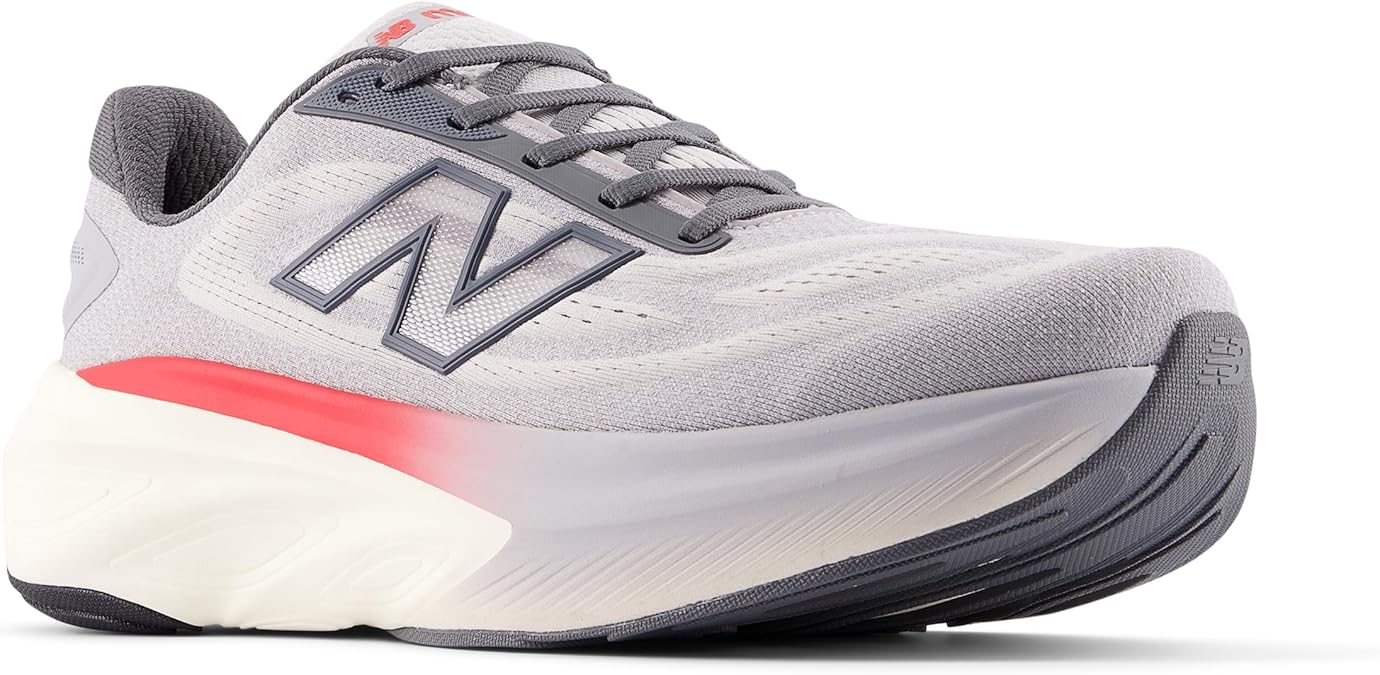
References
- Maximal Shoes & Impact Forces – Pollard CD et al. The influence of maximal running shoes on biomechanics prior to and after a 5K run. Orthopaedic Journal of Sports Medicine, 2018.
https://journals.sagepub.com/doi/10.1177/2325967118761358 - The Comfort Filter Concept in Running Shoes – Nigg BM et al. The “preferred movement path” paradigm: A pragmatic approach to running shoe design. British Journal of Sports Medicine, 2015.
https://bjsm.bmj.com/content/49/20/1290 - Cushioning, Drop & Injury Risk – Malisoux L et al. Influence of the heel‑to‑toe drop of standard cushioned running shoes on injury risk in leisure‑time runners. American Journal of Sports Medicine, 2017.
https://journals.sagepub.com/doi/10.1177/0363546517694476 - Shoe Rotation & Reduced Injury Risk – Malisoux L et al. Can parallel use of different running shoes decrease running‑related injury risk? Scandinavian Journal of Medicine & Science in Sports, 2013.
https://onlinelibrary.wiley.com/doi/10.1111/sms.12054 - Critical View on the “More Cushion = Safer” Idea – Napier C, Willy RW. Emerging evidence against a “cushioning” paradigm of running shoe design. British Journal of Sports Medicine, 2018.
https://bjsm.bmj.com/content/52/24/1564 - ACSM Guidance on Selecting Running Shoes – American College of Sports Medicine: expert tips on comfort, fit, and injury prevention when choosing running footwear.
https://www.acsm.org/read-research/resource-library - Running Shoe Advice from Sports Podiatrists – American Academy of Podiatric Sports Medicine: running shoe selection guidelines and injury considerations.
https://www.aapsm.org/running-shoe-selection.html - Evidence‑Based Overview of Running Shoe Science – Blaise Dubois & The Running Clinic: in‑depth review on cushioning, stability, minimalist vs maximalist, and injury risk.
https://www.therunningclinic.com/en/running-injury-prevention/running-shoes-and-injuries/
Alexios Papaioannou
Empirical Foundation
Every conclusion is built upon a foundation of verifiable data and validated research.
Commitment to Veracity
Each assertion undergoes a meticulous fact-checking process against primary sources.
Actionable Intelligence
Our sole objective is to deliver clear, impartial, and practical insights for our readers.
Founder of GearUpToFit.com and fitness technology expert with 10+ years of experience reviewing sports wearables and GPS watches. Has personally tested over 200 fitness devices and published 1000+ evidence-based articles on fitness technology.